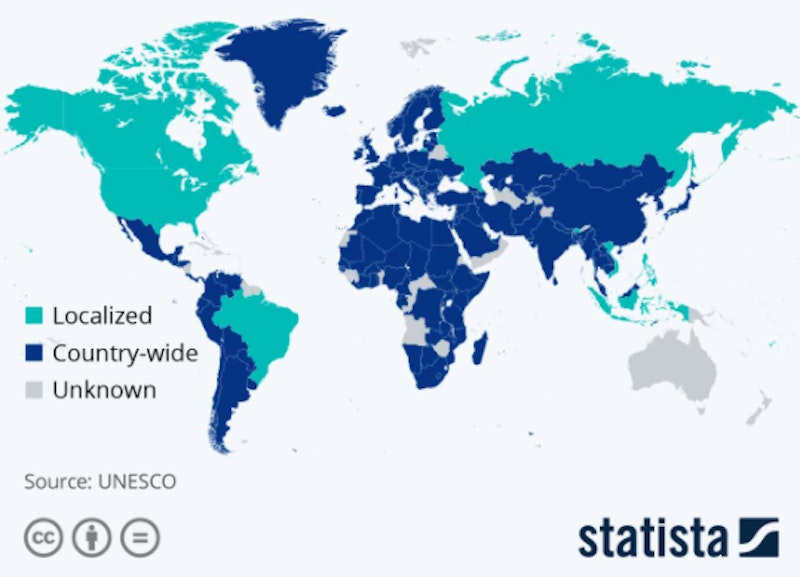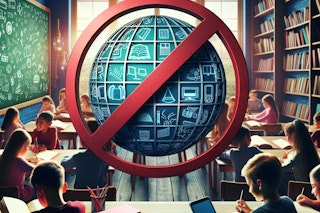The Role Of Education During Coronavirus: What Measures Are Countries Taking To Adapt
COVID-19 has forced the suspension of the worldwide in-person university and school classes with the goal of limiting the spread of coronavirus in the communities. That is why many governments and Educational Technology companies are supporting affected schools and universities by offering access to their tools during the pandemic.
In this article, we will focus on how different countries and institutions across the world are shifting to online learning to combat coronavirus while education continues.
COVID-19 Has Forced 1.4 Billion Students To Stay Home
Regarding Statista, COVID-19 school closures have impacted nearly 1.4 billion students. These numbers include students from primary and secondary education (K-12) and higher education (undergraduate, graduate, and doctoral students), as well as vocational and international students.

Let’s review what some of the countries have done to adapt to the current situation:
China: Online Lessons for 280 Million Students
On February 17th, the Chinese Ministry of Education launched the National Cloud-Platform for Educational Resources and Public, a series of free teaching and learning courses for primary and secondary school students.
Additionally, on March 2, local Chinese schools started classes online and on TV, assigning a television channel for each grade and mailing about 10 books for each student in the country. At first, it was difficult: the connection had to reach 280 million students at the same time. So, those who were in the city center, with more devices and better internet, benefited. This problem increased among the students of level 12, the last one before the Gaokao: the exam that defines the entrance to the universities and that has penalties of up to 7 years in prison for copying.
Regarding Educational Technologies, more than eighty companies offer classes online since the quarantine break began, according to the state newspaper China Daily. One of the most established, Zuoyebang, offers free classes for the main academic subjects from 8:00 am to 5:40 pm. Youdao, a subsidiary of NetEase inc, offers live, streaming classes for 470,000 enrolled students.
South Korea: Schools Closed For the First Time in Its’ History
In the Republic of Korea, a nation where education is among the most competitive and high-pressure in the world, all higher, secondary and primary teaching has also been moved online. This is the first time in South Korean history, according to the Ministry of Education and Korean news outlets. And, even though they were scheduled to open late February or early March they still remain closed.
However, the South Korean government has made it available a wide variety of technology tools, many of them free: Educational Broadcasting System (EBS) provides advanced educational service by offering various multimedia content. Onschool is a portal providing learning materials for students and teachers for K12 levels.
Finally, Jason Reagin, an EdTech consultant, and professor in Incheon, South Korea, has assembled a Wakelet of apps that offer free updates during the global crisis.
Italy: Forced to Learn Digital Teaching
The Italian Government, with 10 million students at home, has moved teaching and research into online during coronavirus lockdown.
According to El Pais, The Italian Deputy Minister of Education Anna Ascani clarified that the country is in a kind of experimental phase: "We are learning by force, not by our own will, but we must make the most of everything we are able to do to take advantage of it on future occasions."
The first schools to close were in the regions Veneto, Lombardy, Emilia Romagna and Liguria, and the Ministry of Education began to offer, through a special website, different tools, multimedia material and advice so that schools can manage education from home.
Those responsible for Education have also asked the national public television Radiotelevisione Italiana (RAI) to modify their morning schedule since there will be many children at home and offer "more space" to education and culture.
Regarding the resources offered by the government, Nuovo Coronavirus is the webpage of the Ministry of Education and Higher Education providing information and guidance for education practitioners and families on the education response to COVID-19. The National Institute for Documentation, Innovation, and Educational Research (INDIRE) is a platform providing webinars for teachers to support them in the adoption of distance learning methodologies and tools.

Spain: Universities’ Need To Boost Online Teaching in Record Time
eLearning had never played such an important role in the Spanish education system. 9.5 million students’ education has abruptly been interrupted due to the COVID-19 and their education now depends on a digital environment that many have had to get used to in a matter of days.
Educational technology has been incorporated in the Spanish classrooms little by little. As Ricardo Palomo, delegate of the Rector for Digital Transformation at CEU San Pablo University, explains at El Economista that their main challenge is the adoption of technology: "if teachers were used to using it already or they had a greater receptivity to the new system." The extraordinary situation being experienced right now will undoubtedly generate changes in the educational methodology and will promote digital teaching.
Spain entered into a state of emergency on the 14th of March and will extend it until at least the 12th of April. The first autonomous community that closed its educational centers was the Basque Country, followed by La Rioja and by the Community of Madrid.
The Spanish Ministry of Education provides now pedagogical resources to support distance learning. Additionally, Procomún offers a collection of close to 100,000 educational resources and learning objects in different formats created by the Spanish Ministry of Education and Science with contributors to the educational community. Finally, Educlan is another online channel supported by the Ministry that presents educational resources during the period of suspension of classes because of the coronavirus.
Denmark: Free eLearning Tools for All Danish Educational Institutions
As a collaboration between the non-profit cluster association EdTech Denmark and the Danish Ministry of Education, 48 Danish digital learning companies will make their learning platforms available free of charge to the country's educational institutions, for all levels from primary school to universities, as long as they remain closed.
For any teachers who may have questions and need help, there will be three highly specialized teachers from Københavns Universitet, Aarhus Universitet, and Danmarks Tekniske Universitet to provide advice and guidance.
"We see it as a relief initiative," says EdTech Denmark director Mikkel Frich, who in just three days succeeded in creating a unified platform that will be active on the domain http://edtechdonor.dk from Sunday, 29th March.
This situation will be a great test of how the education sector is able to handle digital development in a country that is already one of the top EdTech scorers. Norway, Sweden, and Finland have also shown great interest in the initiative.
Finland: Schools Continue To Provide Distance Learning
The Finish Ministry of Education also announced the closure of schools, baccalaureate institutes, vocational training centers and universities throughout the country. However, nurseries and preschool centers will be kept open to allow parents who cannot work virtually and need to go to work.
Since 16 March, all primary, middle and upper secondary schools are providing distance education and students are studying at home. The new site of the Finnish National Agency for Education also aims to answer the needs of students, teachers, and families during the coronavirus outbreak.*
All 24 Finnish universities of applied sciences, with 145,000 students, also started to extensively apply online and distance learning practices to minimize the chances of corona infection. At the same time, the university personnel started to carry out their duties mainly remotely.
The closures are initially expected to last for two weeks, but officials say they are prepared to continue it if needed.

United Kingdom: From Passive To Drastic Measures
Even though the United Kingdom has resisted taking measures at the beginning of the coronavirus crisis, the strategy was hardened when the virus hit the country. London School of Economics, University College London, Durham University, Manchester Metropolitan, and Loughborough were the first to close down class teaching and move online.
Most UK universities already did some teaching online, for example, pre-recorded lectures to help students who would otherwise miss out. However, many staff did not have any experience of teaching wholly online and that involves a different set of skills.
Regarding BBC news, “some schools are requesting older children to follow their existing timetables, involving Google Hangouts Meet and virtual classrooms, and some passive lessons, where children get on with work independently. Each school will have its own system: some will continue to post lessons on Google Classroom daily, others less frequently.”
The Universities and Colleges Union confirms its members are worried about the so-called “lecture capture”. Jo Grady, its general secretary, says: “Moves to record or deliver teaching online in the short term should be voluntary and underpinned with a clear agreement between the union and employers about how the material can be used, as well as appropriate technical support.”
USA: Distance Learning, A Problem Unfolding Across The Whole Country
Since “social distancing” measures began, Columbia, Harvard, New York University, **and other major US colleges and universities have switched to remote classes.
Almost all public schools are now closed in almost all states, and that is creating obstacles keenly familiar around the world. One of the main problems is that many students in the USA lack not only computers but also high-speed Internet connections at home. According to a 2019 report from the Federal Communications Commission, around 21 million people in America don’t have home access to broadband. This means that school districts can’t provide the same online education to every student when some can’t log on at all.
According to Bloomberg, digital inclusion advocates point out that lack of access is key and the states are now assessing how to sustain education without sending kids to school. Many states like Colorado, Minnesota, and Ohio are distributing digital learning devices to students in need during the crisis.
Public TV stations serving some parts of the U.S., including Los Angeles, upstate New York, Detroit, Houston, Boston, and Florida, are also trying to support families and schools with related programming as well.
To conclude, as COVID-19 has been spreading rapidly across Asia, Europe, the Middle East, and the United States, many countries have taken swift and decisive actions to adapt their educational systems to the current situation. Regardless of the different measures of each country, everyone must agree that the COVID-19 has a glimpse at how education could change in the mid-long term.
About the author
About EdTick
EdTick is a platform that helps educational institutions connect with academic software. Join our Beta program and help us shape the future of educational technologies!



